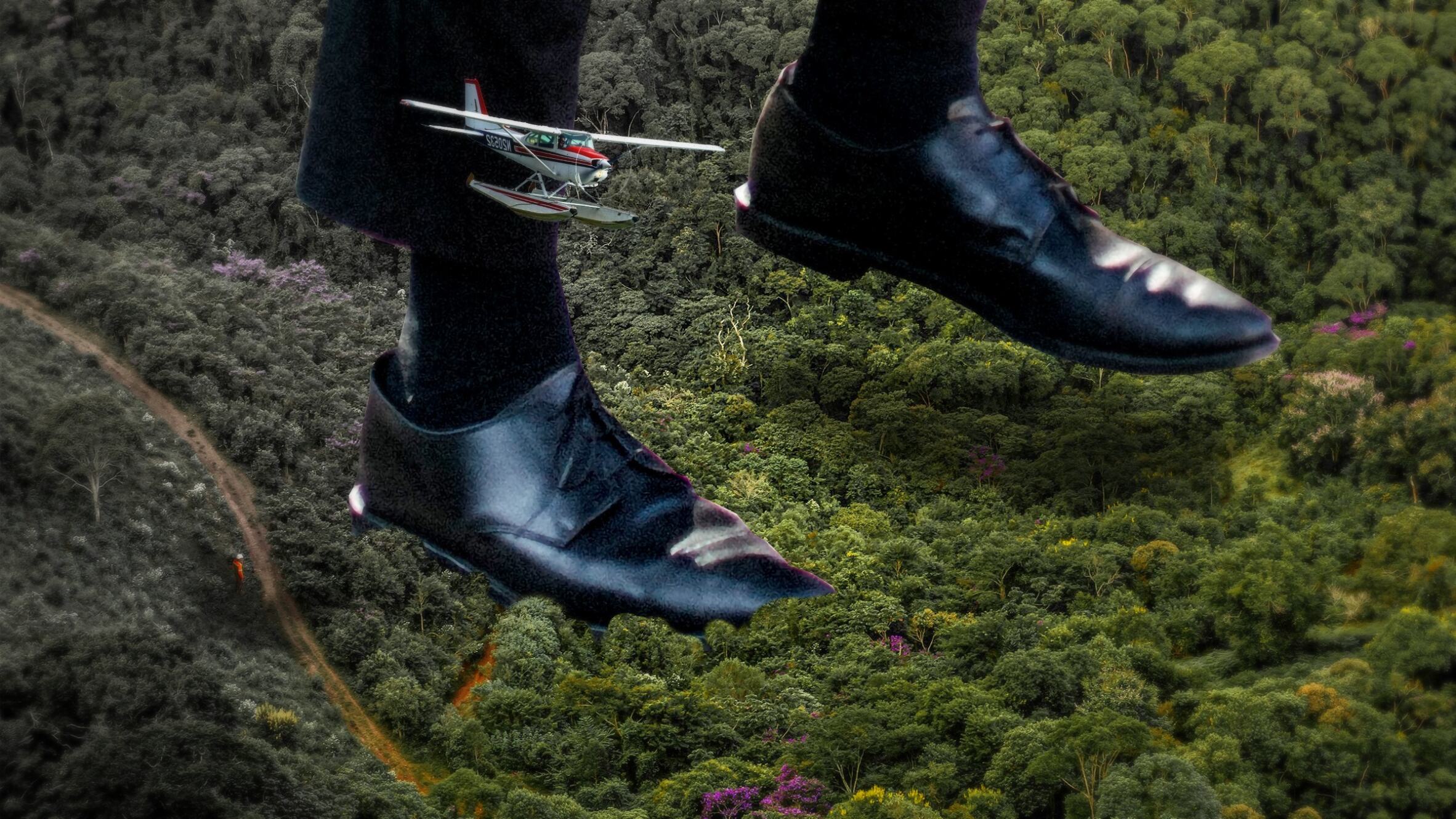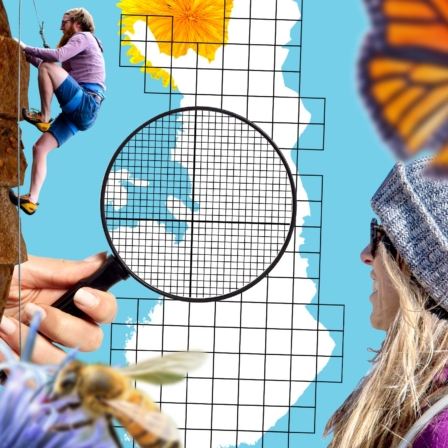The collapse of biodiversity jeopardises our entire economy and well-being, as we are completely dependent on nature. But what we can’t measure, we can’t control.
We will not be able to get to grips with biodiversity until we develop quantitative indicators for our nature impacts.
In December the Finnish Innovation Fund Sitra, Jyväskylä University and Nokia announced a joint effort to develop the calculation of biodiversity footprints towards a common international standard.
But what do we really mean when we talk about biodiversity footprints? What are they, and how do you calculate them? We’ve put together a list of the 10+1 things you need to know about this rapidly developing field.
1. What is a biodiversity footprint?
Almost all human activity affects nature in one way or another. A biodiversity footprint measures this impact. It describes how much damage a product, company, municipality or consumer causes to biodiversity.
A biodiversity footprint can also be positive, meaning that the overall impact is to strengthen nature.
2. It can be calculated
Not long ago, almost every discussion about measuring biodiversity impacts was marred by doubts about the complexity of the exercise. Nature is such a complex web of interactions – is it even feasible to measure our impact on it?
Since then, however, progress has accelerated around the world. In Finland, Sitra and S Group are jointly funding a pioneering project in which researchers at Jyväskylä University will calculate the biodiversity footprint of the entire S Group. The project will also create a general and publicly available method for calculating the biodiversity footprint of any organisation.
At the same time, a second project by Sitra and Jyväskylä University – which will be completed in early 2024 – is, as far as we know, the first to examine the biodiversity footprint of individual consumer choices. The study examines how Finnish consumption affects nature both in Finland and abroad – and what kind of sustainable everyday actions can reduce this burden.
The method for calculating biodiversity footprints was first tested in a pilot project that gauged the footprint of Jyväskylä University. The method is now being further developed in the new S Group project. The same research group is also working on calculating the biodiversity footprint of the City of Tampere.
The interim report (summary in English) of the S Group’s biodiversity footprint calculations was published in May 2023, and its main message is encouraging: Yes, it can be done. Our impact on biodiversity can be measured both in theory and in practice. We already have the knowledge and skills to calculate biodiversity footprints – and then use the information to act.
You might be interested also in
3. Finland is a leader in international research
Methods for measuring biodiversity footprints are being developed rapidly around the world. The Finnish method developed in Jyväskylä is right at the forefront.
It is comparable to other pioneering methods such as the Global Biodiversity Score (GBS), developed by the French CDC Biodiversité and used to calculate the biodiversity footprint of Schneider Electric (pdf), or the Biodiversity Footprint for Financial Institutions (BFFI), originally developed for the Dutch ASN Bank. The BFFI has been used, among other things, to model the development of ASN Bank’s footprint between 2014 and 2020.
The next step is to make Finnish expertise in measuring the biodiversity footprint the best in the world. The conditions are perfect. For example, LUT University is already helping to develop the Finnish calculation method in close cooperation with the University of Jyväskylä, which in turn is initiating doctoral research cooperation with the Finnish Environment Institute and the Natural Resources Institute Finland. There is an opportunity to make Finland a leading research hub for biodiversity footprint calculation.
4. A biodiversity footprint consists of five elements
To understand how a biodiversity footprint is calculated, you need to break it down. What exactly is a footprint? It is the impact of human activity on some aspect of our environment. Just as a carbon footprint measures our impact on the climate, a biodiversity footprint measures our impact on biodiversity.
To calculate this effect, it is necessary to know what human actions are causing it. Our carbon footprint is caused by one thing: our greenhouse gas emissions. Our biodiversity footprint is caused by five factors: the five drivers of biodiversity loss identified by the Intergovernmental Science-Policy Platform on Biodiversity and Ecosystem Services (IPBES).
- Land-use change causes the fragmentation, degradation and loss of ecosystems, for example when forests are cleared for agriculture or wetlands are drained for an infrastructure project.
- Greenhouse gas emissions cause climate warming, which alters the functioning of ecosystems.
- Pollutants, which cover other key emissions, also adversely affect ecosystems. For example, nitrogen and phosphorus emissions cause water eutrophication, while waste products cause soil pollution.
- The direct exploitation of natural resources leads to the depletion of living and non-living natural resources, such as fish stocks or water resources.
- The spread of invasive species alters the functioning of ecosystems.
A biodiversity footprint is the sum of these five pressures: how much of our measurable activity generates land use, greenhouse gas emissions, pollution, overconsumption of natural resources and the spread of invasive species? It is important to note that every biodiversity footprint includes a carbon footprint: the carbon footprint is one of the five measures that make up the biodiversity footprint!
No single calculation method can yet capture all five drivers. Currently, the best available methods cover three or four out of the five. But this already goes a long way. The two most important drivers, land use and climate change, account for most of the average biodiversity footprint.
5. Your footprint is not only about what you do, but also about what you buy
Most of the biodiversity footprint of Finns results from our consumption, and therefore affects regions far beyond our national borders. A large part of everyone’s biodiversity footprint results from the products and services they use.
In most cases, the main impact of a Finnish company’s operations on nature does not occur at its own locations in Finland. The biodiversity impact of an IT company, a grocery store or even a university campus is small compared to the footprint generated around the world in the production of the goods and services it buys – in the places where coffee is grown, trees are felled for furniture, or minerals are mined for producing electronic goods.
A proper biodiversity footprint calculation covers the entire value chain, and these chains are often described as rivers. Raw materials, energy and supplies come from upstream. These are transported to the company’s doorstep and then used to produce products and services. From the company’s facilities and factories, they are then transported downstream to consumers – and from there, as waste or for other end uses.
For primary production companies, such as coffee producers, the largest impact on nature comes from their own operations. For a grocery store, the biggest biodiversity impact is upstream, where the whole array of products that it sells is produced. For a petrol station, on the other hand, the picture is very different: its main biodiversity impact is likely to be downstream, as the petrol it sells is used by consumers, resulting in greenhouse gas emissions.
6. Calculating a biodiversity footprint is a four-step process
In practice, calculating a biodiversity footprint involves four distinct steps:
- Collecting data on the specific operations of the organisation to be measured. This data comes from the organisation’s own systems, usually financial data. Where are our operations located and what do we do in them? What have we procured, from where, and how much?
- After collecting data, the pressures on nature are derived. Once we know what the organisation is doing, it is time to examine how this activity accelerates the five drivers of biodiversity loss. For example, if we source a ton of wheat in the American Midwest , how much land use, greenhouse gases, nutrient emissions, and so on are generated? These calculations make use of global databases that include comprehensive data on the environmental pressures generated by activities in different regions of the world. An example of this is the EXIOBASE database used in the S Group calculation.
- Once the pressures have been identified, the impact on biodiversity is derived. From the results of the previous step, we now know what pressures the organisation is putting on nature. Next, we examine their impact on biodiversity. This is done using a different global dataset: the S-Group calculation project, for example, uses the LC-IMPACT method, which uses models to convert the calculated environmental pressures (“five tonnes of nutrient emissions”) into biodiversity impacts (“biodiversity deteriorates by X units”).
- Combining these impacts to calculate the biodiversity footprint. Finally, the impacts identified in steps 2 and 3 are combined to produce a single value that summarises the impact of all the organisation’s activities: the organisation’s biodiversity footprint.
7. The data is incomplete, but even averages get us a long way
Companies usually do not have comprehensive data on their supply chain. We do not know to what extent, for example, the production of a certain tonne of wheat in the American Midwest negatively affects biodiversity through its land or water use, or how much greenhouse gas or nutrient emissions it generates.
On the other hand, thanks to global databases, we know the average values for the impact of producing a ton of wheat in a given region, such as the American Midwest.
A biodiversity footprint is therefore usually a mathematical average: this activity in this place produces, on average, these impacts on nature.
This is not a flaw in the method, but rather a feature of the data available. The method produces as accurate a biodiversity footprint as the data allows. Where more detailed data is available, the database values can be replaced with accurate data on actual land use, emissions, and so on at different points in the company’s value chain. In this way, a company whose raw materials are produced using more sustainable methods can demonstrate that its footprint is smaller.
8. The search for a common metric continues
There is still no standardised unit of measurement for biodiversity footprints. Different methods produce slightly different units, depending on the underlying databases and models. Below are some of the units currently in use:
- Potentially disappeared fraction of species (PDF), either regional or global
- Mean species abundance (MSA)
- Habitat hectares (HH)
- The STAR score, developed by the International Union for Conservation of Nature
As long as there is no common international unit of measurement for biodiversity footprints, the results of different companies and other organisations cannot be compared.
The next step is to determine whether the best measures currently in use can be made compatible with each other: can we find a common language to translate one indicator into another?
This is precisely the objective of the new Sitra-funded project at Jyväskylä University. If it succeeds, we will be just a small step away from a common, global measure.
9. We need a global benchmark
Not every hectare of land is ecologically equivalent. The loss of a hectare of tropical rainforest in Madagascar is worse for biodiversity than the loss of a hectare of species-poor tundra. A hectare of endangered herb-rich forest is of higher natural value than a hectare of non-endangered forest.
Since a company’s biodiversity footprint can affect a wide range of ecosystems around the world, how can their ecological importance be compared?
There are three factors that must be considered when aggregating the impact of human activities on nature into a single unit of measurement:
- The affected area. How large is the area affected by the activity being measured?
- The change in ecological status. How much is the ecological status of the area degraded due to the human activity being measured? Ten per cent? Fifty per cent? A hundred?
- The ecological significance of the area. What is the ecological significance of the change in the area being measured?
None of the leading measures currently under development fully incorporate all three factors. The latter is missing from most calculation methods.
The unit of measurement used to calculate S Group’s biodiversity footprint – the Global Potentially Disappeared Fraction of species (gPDF) – is very promising from this perspective. It asks by how much does the human activity being measured increase the likelihood of species disappearing not only from a particular area, but worldwide.
Measured in this way, the biodiversity footprint becomes commensurate, as the company’s biodiversity impacts on different ecosystems around the world can be compared using a single benchmark. For example, a company that produces products in Colombia can be compared with a company that makes sources from Indonesia, Spain and Finland. In this way, the Finnish metric under development at Jyväskylä University takes us a step further than many of the methods being developed elsewhere.
10. But what does it mean?
The current challenge with the chosen unit of measurement (Global potentially disappeared fraction of species) is its communicability. Even a sizeable biodiversity impact of an individual organisation can easily look like a small crumb when compared to total global biodiversity. Even if the effect is large, it will not seem so if it is represented by a tiny decimal number.
This is not a problem with the validity of the calculation method. But to achieve the greatest impact, it is important to ensure that the measure can be communicated as clearly as possible to the company’s management team, clients, stakeholders and the general public.
As the work progresses, it is important to examine how to make the unit of measurement more comprehensible. For example, the Dutch ASN Bank mentioned above ultimately translates the potentially disappeared fraction of species into hectares – therefore estimating that a certain number of hectares of pristine nature is lost because of the bank’s investment activities.
+1 Mainstreaming the biodiversity footprint? It’s closer than you think.
The development of methods for calculating biodiversity footprints is now moving at a tremendous pace. The Finnish biodiversity footprint calculations are progressing, becoming more specific and deeper. The methods are approaching the point where we can move from pilot projects to wider use. This is good news for all companies and other organisations that want to calculate their own biodiversity footprint.
Today, the demand for footprinting calculation services still massively outstrips supply. The bottleneck is the lack of people with sufficient expertise to do the calculations. This situation will improve once the measure moves out of the pilot stage and becomes sufficiently established.
We are already approaching the threshold where consultancy firms can take hold of the method and start developing a biodiversity footprint calculation service for their clients, similar to carbon footprinting.
If we play our cards right here in Finland, biodiversity footprint calculations could become mainstream within just a few years – and Finland could become an international leader in this field.
Read more:
Finnish researchers pave the way for a common international biodiversity footprint metric





















Recommended
Have some more.